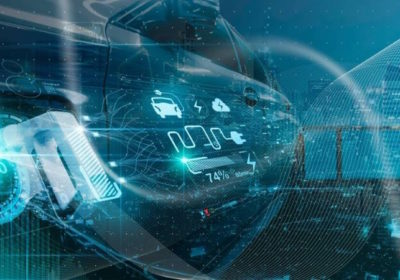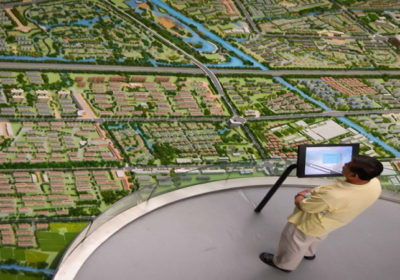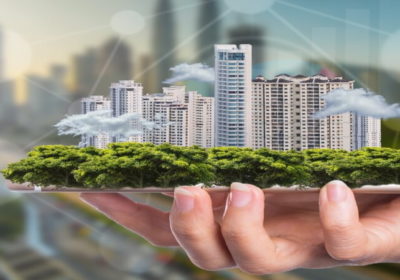
When we analyze the impact that new technologies are having on our society, we know that the disruption that elements such as IoT, 5G communications or the protocols developed to support cryptocurrencies have on the global economy is not a new topic of discussion. They are forcing us all, as human beings and members of a society that is advancing at tremendously high speeds for what we have been used to in recent decades, to rethink the way we live together and what our cities of the future are going to be like.
All the new socioeconomic models are intertwined with digital alternatives to do online almost anything we want within the urban environment in which we live. We can use an app for almost anything we need to do in our daily lives, and we can use instant communication technologies with members of governments and local and regional authorities to send them requests for information, carry out bureaucratic procedures or report problems in our neighborhoods. Everything that used to have to be done through long, face-to-face queues, or where physical paperwork had to be completed, although it has not disappeared, is now at the touch of a finger on a cell phone or computer.
So can society make such a radical transformation and move towards 100% online interaction for everything without being plunged into chaos or confusion? The new generations can perhaps do it, they are used to it, because they have evolved with technology under their arms while growing up.
But what about those who were born when there were no mobiles or tablets? Can they quickly adapt to issues such as neighborhood services having to be requested by email or via app? What will happen when we manage to successfully implement urban transport models based on the absence of human drivers? The early-adopters will be the first to get on them, but how long will it take for an “average” adult who still looks askance at the processes imposed on them by technological progress to even accept a test to see if they can trust these vehicles or not?
The danger of leaving a part of the population behind
The challenges facing Smart Cities are enormous to incorporate citizens to the new facilities that technologies bring in leaps and bounds, because in a demography where only a small part of the population is willing to use everything that the digital era brings with it, the rest look at it with concern, or at least indifference, because it is something they do not understand. How will we manage to incorporate all citizens so that they feel part of the transformation process of our society based on urban development models where all kinds of technological systems that most of us do not understand are mixed?
The challenge of smart and connected cities is twofold in this sense, not only is it necessary to modify the infrastructure of all communication services, Internet, databases, cloud computing systems and blockchains where information is stored so that it can be seen by everyone simultaneously, but it is also necessary to find a way to overcome the resistance of people who fear, or may fear, that all these advances will bring more inequality to the society in which they live, opening and deepening the gap between those who use and understand and quickly adopt the new technologies, and the models of use of the same, and those who still do not understand them, nor use them, nor adapt to them for convenience, for relying on what is already established, for lack of interest or simply for lack of knowledge.
It is clear that in any society there are always elements that are at the forefront of development, driving projects and the implementation of new systems, changes in the organization and planning of the city or region, and activating and “testing” everything that industry and technology companies offer, develop and promote. However, the vast majority of people are in that “long tail”, the caboose, going at a very slow pace of understanding and adapting to the new. Do we lack technological education that we would have to start developing and offering free of charge to our citizens so that they can participate more actively in all the new projects that our city can put in place? Or do we lack explaining and making society easily understand the advantages (and disadvantages) that these rapid advances and changes can bring to their lives?
When the “old” is still working, innovations take longer to be accepted
When a city starts its transformation into a Smart City with a long-term plan, institutions and technology clusters, business and start-up ecosystems are the first to start demanding regulations that allow them to launch and accelerate their projects, research and developments. But when the city already becomes a Smart City, there is also resistance from a part of the population that does not want anything to change because they are used to a way of doing things. How can we help people to lose their fear of technological development? How can we encourage creativity and research in our companies, but prevent them from going so fast that no one can keep up with the technological products and systems they develop and that we cannot apply? We are starting the deployment of 5G technologies around the world but there are still companies, industrial ecosystems and people who are still connected to a 3G network, and they are doing well, it is more than enough for what they need and they are not particularly interested in changing technology, unless there is no other option because the one they are using breaks or is no longer functional.
Is it necessary then to wait for the latecomers to stop using the “old” completely to implement the “new”? It would be more productive to insert and create processes of accompaniment and transformation in society towards the technological models that we want and wish to implement, in such a way that, without stopping using what works for a part and is sufficient for them, allows them to start a process of adaptation to the new, to what is proposed as the revolution of urban life, in terms of communications, education, health, economy, transportation and all the other areas in which these technological changes are going to have a strong impact on us.
The use of virtual assistants and chatbots that respond to us almost as if they were human also arouses a complete rejection of those who still prefer to talk to a person when they have a problem in any service they have contracted or may need. While there is certainly an imposition for all types of companies towards digital transformation, the drive towards faster and more agile development has to be accompanied by processes in which the non-digital population is not left behind. Like a comet, which always drags its tail at the same speed as its head advances, leaving none of its parts behind to disperse or get lost along the way, the urban transformation of our society cannot leave the vast majority behind while incorporating new technologies and accelerating the disposal of old ones. For this to work, we must accompany people to understand the changes that will occur at the same time that their technological ecosystem enables and facilitates those changes. Only in this way will our society stop stretching like a rubber band in which there is an increasing gap between those who are ahead and those who are lagging behind, because, practically, at the rate we are evolving, we will have achieved in a few years of technological progress what the whole of humanity has not advanced in its entire history as a civilization, and this leads us to the risk that the most lagging part will be “marginalized” within the processes of social and urban transformation that we are carrying out.
Facilitating the path of technology to the people
To avoid this, viable alternatives are proposed that can be implemented from this very moment, starting by breaking the fear of technological change with all kinds of social and cultural events for those who will never approach a conference on the Internet, mobile or new transportation or communications alternatives. Bringing progress closer is indispensable for those who are now looking for ways to adapt to a constantly changing urban ecosystem that reaches the general public several years behind the “latest model” of what the industry researches or launches in its laboratories and research departments.
In addition, it is necessary to look for protocols to reduce the psychological impact that the digital transformation of society may have. Not everyone is yet at ease in a model in which everything is computerized, in which everything is done through the Internet or human-machine interaction systems, in which you order a coffee and it is served to you by an automated system that is designed to prepare it exactly as you want it, or in which the shopping list you make every week at the supermarket is already recorded in some app on your mobile and you only have to press a button to get it home without any further interaction between you and those who have been in charge of preparing it and bringing it to you.
The fear that awakens the loss of interaction between people, the “warm” touch that usually exists when someone has a problem and another person empathetically solves it, will possibly disappear if all that attends us in a few years are chatbots and artificial intelligences that will navigate between all the options of all the menus of all the systems and products that we have contracted to solve the questions, doubts or complaints that we have. And they already do it in such a perfect and objective way that it will be difficult to discharge any kind of frustration towards this type of systems and their answers.
City services may no longer be restricted to the city limits
The moment we can manage our home stuff from the office (many things can already be done this way with an Alexa-like system), when we can request help or a delivery or something no matter where we are at the time (something that can be done in many cities), or when we can request a medical appointment and be attended by video consultation wherever we are (something that is already possible in certain places with good connectivity), society will no longer be subject to physical spaces and locations and limits of operability, since services for citizens can be provided hundreds of kilometers away from their “physical” residence within the “physical” perimeter of the city itself.
Thus, the so-called “digital operability” will be extended to the citizen who does not need physical presence to be part of what his Smart City allows him to do. Thus, the concept of “resident” in a city is expanded because if we are able to control our entire house hundreds of kilometers away with home automation and technological systems, it becomes difficult to differentiate whether we live in it or just keep it at a distance. In short, the concept of citizenship expands to the world of digital identity where a passport or physical document with a written address will not be at all indicative of the reality of that person or their status as a permanent inhabitant of that city. On the other hand, teleworking and remote connection to companies in the city can become a challenge that is already being widely implemented in many places, cities and countries, and it does not matter where you live to be able to say that you work in Barcelona or Sao Paulo, because your residence is not indicative that you are not exercising your profession in a company whose headquarters is thousands of kilometers away from you, counting as an employee and registered in that locality, but leading your life in another point far away from it.
Finally, the possibility of human interactions disappearing and changing with every technological development is already a fact that we will see more and more frequently in the coming years and, therefore, a reality implemented in many areas of our modern society. But few of us will get so used to talking to machines that do have “all the answers” that we will not prefer a human service on the other side.
We will have to see how to assist the entire population so that no one is left behind in the implementation of technology in all areas and corners of our cities, and of our lives, so that we manage to break the psychological barriers of rejection to change, finding ways and integrating the elements that are necessary to accompany this adaptation and ensuring that it is done progressively and gradually. In the meantime, we will surely continue to help and support those who are years ahead in knowledge, inventiveness and development, so that what the technological ecosystems, the nuclei of companies and start-ups develop, reaches everyone else as quickly and comfortably as possible, and allows us to embrace the help that technology gives us without losing the sense of human society that unites us and binds us all together for the greater common good of our civilization.



